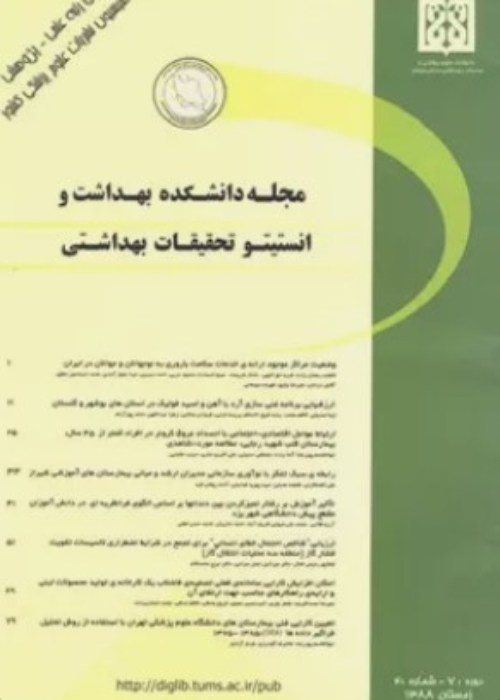The relationship between nutritional factors and breast cancer in women attending Imam Hospital
Author(s):
Abstract:
Background And Aim
Breast carcinoma is the most common type of cancer in women. It has been estimated that 8-9 percent of all women will develop breast cancer during their lifespan. According to The Iranian Ministry of Health and Medical Education, the incidence of breast cancer in Iran has risen between 1984 and 1988 and the current mortality rate from this kind of cancer ranks fifth in the country.Materials And Methods
In this case-control study, 110 patients with breast cancer (ages 20-60 yrs) were compared with a similar number of age- and sex-matched women hospitalized for other reasons. Cases were women with histologically confirmed in situ or invasive breast cancer diagnosed no more than 1 year before the interview and with no previous diagnosis of cancer at other sites. Controls were drawn from either patient relatives or from women with no history of cancer admitted to Imam Hospital for acute, non-neoplastic, non-gynecologic conditions unrelated to hormonal or digestive tract disease or to long-term diet modifications. We calculated odds ratios and performed Mantel-Haenzel as well as logistic regression tests to control for potential confounding factors. Results
Odds ratios [with 95% confidence intervals] for total fat, saturated fatty acids, monounsaturated fatty acids (MUFA), polyunsaturated fatty acids (PUFA) and cholesterol were 1.97 [1.062-3.67], 1.19 [0.64-2.14], 2.2 [1.17-4.13], 4.11 [2.2-7.65] and 0.45 [0.25-0.83], respectively. After adjusting for energy, macronutrients, weight, age at first full-term pregnancy and the socioeconomic status, it emerged that the intake of PUFA (OR=6.38 and 95%CI: 1.95-20.83) had a positive association with breast cancer while cholesterol (OR=0.22 and 95%CI: 0.09-0.55) showed a negative relationship, though the latter finding only applies to menopaused women.Conclusion
Undoubtedly, dietary factors involved in the etiology of breast cancer take many years to cause any pathologic changes in any organ. Nonetheless, one-year frequency of lipid intake is a good measure of individual's dietary habit throughout his/her adult life. Based on this, the present study suggests that increased PUFA intake- probably due to its high pro-oxidant potential- can be considered as a key factor in the rising incidence of breast cancer in Iran.Language:
Persian
Published:
Scientific Journal of School of Public Health and Institute of Public Health Research, Volume:5 Issue: 4, 2008
Page:
35
magiran.com/p567782
دانلود و مطالعه متن این مقاله با یکی از روشهای زیر امکان پذیر است:
اشتراک شخصی
با عضویت و پرداخت آنلاین حق اشتراک یکساله به مبلغ 1,390,000ريال میتوانید 70 عنوان مطلب دانلود کنید!
اشتراک سازمانی
به کتابخانه دانشگاه یا محل کار خود پیشنهاد کنید تا اشتراک سازمانی این پایگاه را برای دسترسی نامحدود همه کاربران به متن مطالب تهیه نمایند!
توجه!
- حق عضویت دریافتی صرف حمایت از نشریات عضو و نگهداری، تکمیل و توسعه مگیران میشود.
- پرداخت حق اشتراک و دانلود مقالات اجازه بازنشر آن در سایر رسانههای چاپی و دیجیتال را به کاربر نمیدهد.
In order to view content subscription is required
Personal subscription
Subscribe magiran.com for 70 € euros via PayPal and download 70 articles during a year.
Organization subscription
Please contact us to subscribe your university or library for unlimited access!


